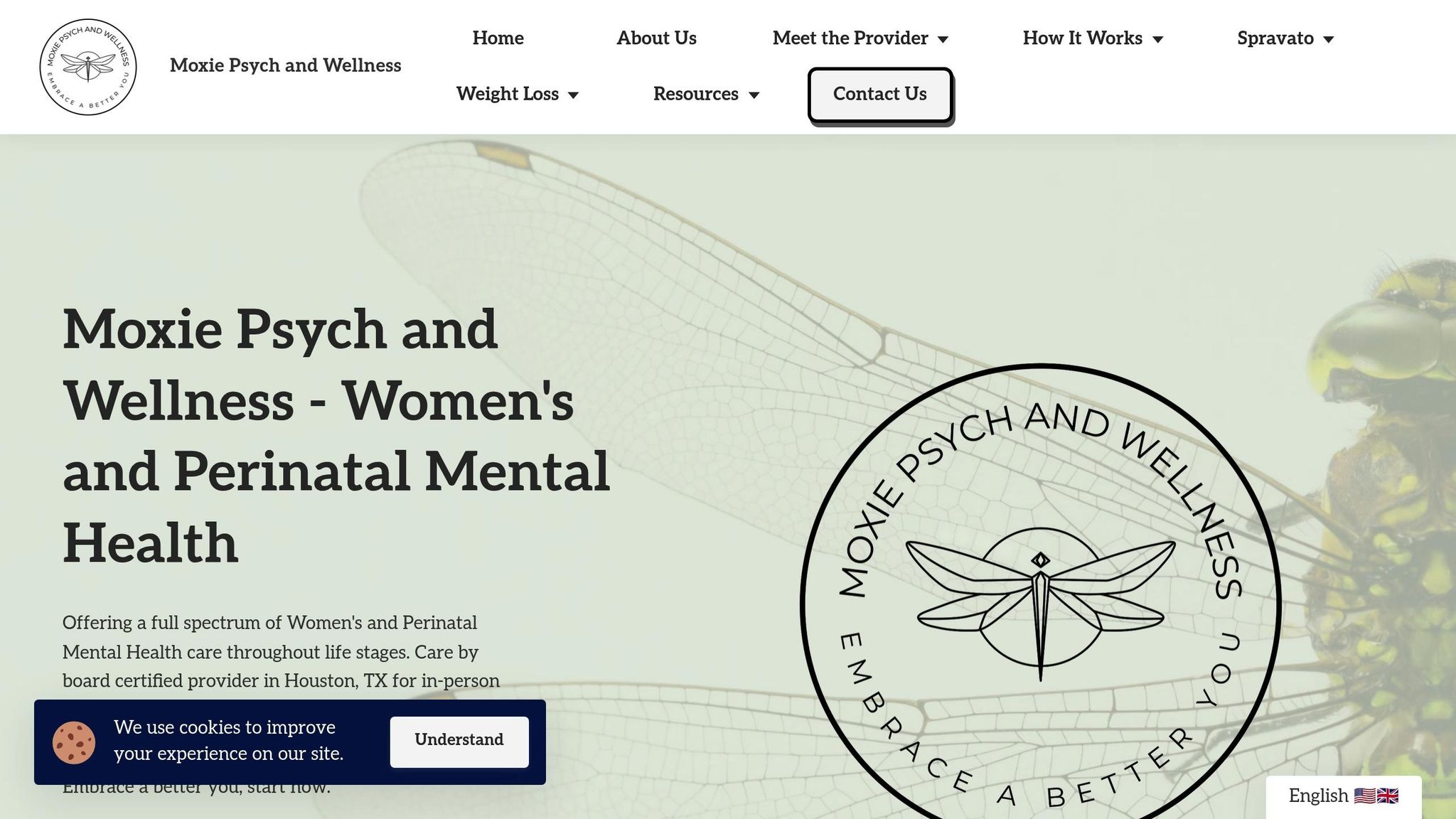Mindfulness yoga is a gentle way to reduce anxiety during pregnancy, combining safe yoga poses with meditation. It helps manage physical discomfort, racing thoughts, and emotional overwhelm, making it easier to navigate this transformative time. Studies show it can improve sleep, stabilize mood, and even prepare you for labor and early motherhood.
Key Takeaways:
- What It Is: Combines yoga and mindfulness meditation to calm the mind and body.
- Why It Works: Eases physical tension, reduces stress, and promotes present-moment awareness.
- Benefits: Better sleep, reduced anxiety, and improved overall well-being for mother and baby.
- Techniques: Includes poses like Cat-Cow, Child’s Pose, and breathing exercises like Deep Belly Breathing.
- Daily Practice Tips: Dedicate 10–15 minutes to a simple routine in a quiet space.
This practice is most effective when paired with regular prenatal care and mental health support if needed.
Prenatal Meditation ♥ Mindfulness Pregnancy Yoga Relaxation Techniques For Stress & Anxiety ♥
Understanding Anxiety During Pregnancy
Pregnancy brings a whirlwind of changes - physical, emotional, and mental. Feeling anxious along the way is a completely normal experience for many. Acknowledging these feelings is often the first step toward finding support and trying practices like mindfulness yoga. This can help manage the challenges that come with this transformative time.
What is Perinatal Anxiety?
Perinatal anxiety refers to persistent worry or fear tied specifically to pregnancy and the postpartum period (the first year after giving birth). It can show up as racing thoughts, difficulty sleeping, or physical symptoms like a pounding heart or shortness of breath.
This type of anxiety often disrupts daily life. For example, some women might obsessively monitor their baby's movements, feel overwhelmed by decisions about baby care, or constantly worry about labor and delivery. It's one of the more common mental health challenges during pregnancy and can feel all-encompassing at times.
Common Triggers of Anxiety During Pregnancy
Several factors can heighten anxiety during pregnancy. Hormonal changes, for instance, play a big role. Shifts in estrogen and progesterone levels can affect brain chemistry, which in turn impacts mood and emotional balance.
Another major source of worry is concern for the baby's health. Routine prenatal checkups and screenings, while essential, can become moments of intense stress. On top of this, big life changes - like financial pressures or shifts in relationships - can add to the emotional load. For those with a history of anxiety, depression, or other mental health conditions, the risk of experiencing perinatal anxiety may be even higher.
Effects of Untreated Anxiety on Mother and Baby
When anxiety during pregnancy goes unmanaged, it can affect both mother and baby. For the mother, untreated anxiety can lead to complications during delivery, disrupt sleep, and leave her feeling drained. It can also interfere with bonding with the baby and increase the likelihood of postpartum mental health struggles.
For the baby, maternal anxiety can influence early development and create challenges in the bonding process. Addressing these feelings early on is key to supporting both the mother's well-being and a healthier pregnancy experience.
How Mindfulness Yoga Reduces Anxiety
Mindfulness yoga combines gentle movements, focused breathing, and present-moment awareness to help ease anxiety during pregnancy. This approach works on multiple levels - physical, mental, and emotional - providing comfort and fostering a sense of balance.
What is Mindfulness Yoga?
Mindfulness yoga merges traditional yoga poses with mindfulness meditation practices. The key focus is staying present, steering away from worries about the future or lingering over past regrets. As you move through poses and breathing exercises, attention is directed to physical sensations and the steady support of the ground beneath you. By slowing down and holding poses longer, this practice encourages you to observe your experience without judgment, using your breath as a steadying tool whenever anxious thoughts creep in.
Research on Mindfulness Yoga
Studies highlight the calming effects of mindfulness yoga, showing it can significantly reduce anxiety and improve sleep quality in pregnant women. Beyond psychological relief, the practice has been linked to physiological benefits, such as a more stable heart rate, which signals reduced stress. Some research even suggests that regular mindfulness yoga may lead to changes in maternal brain structure, hinting at effects that could be both deep and long-lasting.
Benefits Beyond Anxiety Management
The advantages of mindfulness yoga extend well beyond managing anxiety. It has been associated with better pregnancy outcomes, including shorter labor durations and higher Apgar scores for newborns. Additionally, it may strengthen the bond between mother and baby before birth. The mindfulness skills and coping strategies developed through this practice can also carry over, helping you manage stress not only during pregnancy but well into early motherhood. With these benefits in mind, let’s dive into some practical mindfulness yoga techniques tailored for expectant mothers.
Mindfulness Yoga Techniques for Pregnant Women
Discover safe and gentle mindfulness yoga techniques designed to ease anxiety during pregnancy. These practices are tailored to adapt to your changing body, offering support for both your physical and mental well-being.
Safe Prenatal Yoga Poses
Here are some prenatal yoga poses that are both safe and calming:
Cat-Cow Pose is a go-to for relieving back tension and promoting relaxation. Begin on your hands and knees, aligning your wrists under your shoulders and your knees under your hips. Inhale as you gently arch your back and lift your chest (Cow Pose), then exhale as you round your spine toward the ceiling (Cat Pose). This rhythmic flow encourages deep, steady breathing while easing physical discomfort.
Child's Pose offers a quiet moment of rest. Start by kneeling on the floor with your big toes touching and your knees spread wide to accommodate your belly. Sit back onto your heels and fold forward, stretching your arms out in front of you or resting them alongside your body. This pose creates a sense of calm and allows you to focus inward on your breath.
Supported Warrior II helps build strength and stability in a gentle way. Stand with your feet about 3-4 feet apart. Turn your right foot out 90 degrees and bend your right knee so it aligns over your ankle. Rest your left hand on your hip and extend your right arm forward, using a chair or wall for support if needed. This pose fosters a sense of grounding and confidence.
Legs-Up-the-Wall Pose is especially soothing in later pregnancy. Sit sideways near a wall, then roll onto your back and extend your legs up against the wall. Place a pillow or bolster under your lower back for added support. This restorative position improves circulation and encourages deep relaxation by activating your body’s calming mechanisms.
Breathing Exercises for Calm and Relaxation
Breathing techniques can be powerful tools for managing anxiety. Here are a few to try:
Deep Belly Breathing helps shift your body into a state of calm. Rest one hand on your chest and the other on your belly. Slowly inhale through your nose for a count of four, allowing your belly to rise, and then exhale through your mouth for a count of six. This practice promotes relaxation and reduces stress.
Three-Part Breath enhances breath awareness. Begin by breathing into your belly, then expand your breath into your ribcage, and finally into your upper chest. Exhale in reverse order. This full, deliberate breathing pattern boosts oxygen flow and creates a calming rhythm.
4-7-8 Breathing is useful for managing heightened anxiety. Inhale through your nose for 4 counts, hold your breath for 7 counts, and exhale through your mouth for 8 counts. Start with just a few rounds and increase as you become more comfortable with the technique.
Humming Breath introduces a soothing vibration to your breathing. Take a deep inhale, and as you exhale, hum softly to create a gentle buzzing sensation in your chest and throat. This vibration helps calm the nervous system and reduce stress.
Guided Mindfulness Meditations
Incorporating mindfulness meditations into your routine can further ease anxiety and deepen your connection to yourself and your baby:
Body Scan Meditation involves focusing your attention on each part of your body, starting at your forehead and moving down to your feet. Spend 30-60 seconds on each area, breathing into any tension you notice. This practice encourages relaxation and helps release physical stress.
Loving-Kindness Meditation nurtures positive emotions. Place your hands over your heart and repeat phrases like, "May I be happy, may I be healthy, may I be at peace." Extend these wishes to your baby by saying, "May you be happy, may you be healthy, may you be safe." This meditation fosters a sense of connection and emotional well-being.
Mindful Movement Meditation combines gentle movement with focused awareness. Stand comfortably and make slow, circular movements with your arms, paying close attention to the sensations in your body. This practice helps quiet your mind and keeps you rooted in the present moment.
Breath Awareness Meditation encourages you to observe your natural breathing pattern. Sit comfortably and notice where you feel your breath most - whether at your nostrils, chest, or belly. If your mind starts to wander, gently bring your focus back to your breath. Even a brief session of five minutes can help reduce anxiety.
These practices are most effective when done consistently, even if for just a few minutes daily. Start with the poses and breathing exercises that feel most natural, and gradually explore the meditations as you gain confidence. Up next, learn how to seamlessly weave these techniques into your daily life.
sbb-itb-3d00657
How to Add Mindfulness Yoga to Your Daily Routine
Mindfulness yoga can easily become a part of your day without requiring special equipment or a lot of time. By building on the techniques mentioned earlier, incorporating it daily can deepen its positive effects.
Setting Up Your Practice Space
Start by designating a quiet and consistent spot for your practice. It doesn’t have to be a large area - just a corner in your bedroom or living room where you can be undisturbed. Sticking to the same space each time helps your mind associate that area with relaxation and focus.
Equip your space with essentials like a yoga mat and a few supportive props. A bolster or pregnancy wedge can make poses like child’s pose more comfortable, while a folded blanket can provide extra cushioning or keep you warm during meditation. Yoga blocks are great for modifying poses, and a sturdy chair can offer support for standing poses if balance is tricky.
For atmosphere, let natural light brighten your morning sessions, or use a soft lamp for a calming evening vibe. Keep your props organized in a small basket, and consider having a journal and pen nearby to jot down your thoughts or track your progress.
Daily Mindfulness Yoga Routine
Once your space is ready, creating a simple routine can make mindfulness yoga a seamless part of your day. Even just 15-20 minutes daily can help ease anxiety without feeling like a chore.
- Morning routine (10-15 minutes): Begin with three minutes of deep belly breathing. Then, do gentle cat-cow stretches for two minutes, followed by supported warrior II on each side for one minute. Wrap up with a five-minute body scan meditation.
- Evening routine (15-20 minutes): Start with child’s pose for three minutes, then practice three-part breathing for five minutes. Follow this with five minutes in legs-up-the-wall pose, and finish with a five-minute loving-kindness meditation.
- Flexible mini-sessions: On busy days or when anxiety hits unexpectedly, try quick breathing exercises or simple stretches. These can be done at your desk, in the car, or even while waiting for an appointment.
- Weekly variations: Mix things up to keep your practice fresh. Alternate between energizing poses, restorative sessions, and meditation-focused routines throughout the week. This variety can help address different needs and keep you engaged.
Tracking Your Progress
Keeping track of your practice can help you see its impact on your well-being over time. Regularly note how you feel before and after each session to recognize changes.
Start by rating your anxiety on a scale of 1-10 before practicing, and jot down any specific worries or physical sensations. After your session, record your post-practice anxiety level and any noticeable shifts in mood or comfort. This simple habit can highlight the immediate benefits of mindfulness yoga.
Beyond anxiety, pay attention to areas like sleep quality, back pain, energy levels, and digestion. Note your overall mood, how you handle daily stress, and moments when you felt more connected to your baby. If you successfully used breathing techniques during a stressful situation, write it down - it’s a win worth celebrating.
At the end of each month, review your notes to spot patterns and adjust your routine as needed. Celebrate small victories, like completing a full week of practice or staying consistent during a tough period. These moments can keep you motivated and remind you of the value of prioritizing your mental and physical health.
Support and Resources for Perinatal Mental Health
Mindfulness yoga can be a great way to manage anxiety during pregnancy, but it’s most effective when paired with professional care and a solid support system. Having access to the right resources ensures you’re well-supported throughout your pregnancy journey, while combining mindfulness yoga with expert guidance can significantly improve your overall well-being.
Talking to Your Healthcare Provider
Your healthcare provider should be your first point of contact when considering mindfulness yoga or any new wellness practice during pregnancy. Share your anxiety symptoms openly with your doctor or midwife to determine whether what you’re experiencing is within the normal range or if additional mental health support might be helpful. Be specific about when your anxiety tends to arise, what triggers it, and how it’s affecting your daily life.
Discussing your mindfulness yoga routine with your provider is also crucial for ensuring safety and maximizing its benefits. They can recommend specific yoga poses and breathing techniques that are safe for your stage of pregnancy, especially if you have any conditions that require extra precautions.
How Moxie Psych and Wellness Can Help

If anxiety during pregnancy starts to feel overwhelming or disrupts your daily routine, specialized perinatal mental health care can make a big difference. Moxie Psych and Wellness offers tailored mental health services specifically for women and expecting mothers.
"Moxie Psych and Wellness, PC is committed to providing holistic and patient centered care. Providing treatment for a variety of mental health conditions across all age groups, Moxie Psych and Wellness, specializes in perinatal & women's psychiatric care." [3]
For residents of Houston, TX, the practice provides in-person psychiatric evaluations, while virtual services are available for those in Delaware, Florida, Georgia, Iowa, Kansas, and Montana [1][3]. This flexibility ensures that expert care is within reach, no matter your location or physical limitations during pregnancy.
Brandi Starks, a board-certified provider specializing in perinatal mental health, offers customized treatment plans aimed at empowering you and improving your overall well-being [1][2][3]. Their Concierge Level Care model provides enhanced privacy, quicker access, and flexible scheduling options, including evenings and weekends [1].
Moxie Psych and Wellness also offers a free 15-minute consultation to discuss your concerns and determine if their services are the right fit for you. Their approach involves thorough evaluations, collaborative treatment planning, and ongoing adjustments to ensure the best outcomes for your mental health [2].
Finding Additional Resources
Beyond professional care, there are plenty of community and online resources to support your mindfulness yoga practice. Many local hospitals, birthing centers, and community organizations host prenatal yoga classes led by certified instructors trained in pregnancy-safe techniques. Online platforms also offer guided sessions with qualified prenatal yoga instructors, as well as mental health apps that include meditation and mood-tracking features.
Support groups, whether in-person or virtual, can provide a sense of connection and shared understanding with others experiencing similar challenges. When exploring these options, make sure the programs prioritize safety during pregnancy and are led by instructors or facilitators with proper certifications, such as those from Yoga Alliance.
Conclusion: Using Mindfulness Yoga for a Healthy Pregnancy
Mindfulness yoga offers a gentle and natural way to navigate the emotional ups and downs of pregnancy. Studies show that practicing mindfulness yoga can help reduce stress, ease anxiety, and improve overall mental health - key ingredients for a smoother and healthier pregnancy experience.
But the benefits don’t stop there. This practice can also lead to better sleep and a more positive mood. Many expectant mothers discover that mindfulness techniques, like focused breathing and gentle movement, help them manage fears about childbirth and cope with the physical and emotional demands of pregnancy. The beauty of mindfulness yoga lies in its simplicity and adaptability - it’s an approach that fits seamlessly into everyday life.
Even setting aside just 10–15 minutes a day for gentle stretches and breathing exercises can make a noticeable difference. The key is consistency, not intensity. This makes mindfulness yoga an accessible option for anyone, regardless of experience level.
That said, mindfulness yoga works best when paired with regular prenatal care. While it’s a powerful tool for managing anxiety and stress, it’s important to combine it with routine check-ins with your healthcare provider and, when necessary, professional mental health support.
FAQs
How can I safely include mindfulness yoga in my pregnancy routine to help with anxiety?
Incorporating mindfulness yoga into your pregnancy routine can be a soothing way to ease anxiety. Begin with prenatal yoga poses that are safe for your stage of pregnancy. Keep your sessions short - about 5 to 10 minutes - focusing on deep breathing, gentle movements, and staying present in the moment. Once you feel at ease, you can gradually increase the length of your practice.
It's important to consult your healthcare provider before starting any new exercise to make sure it’s safe for both you and your baby. Practicing mindfulness yoga regularly can help lower stress levels, promote relaxation, and deepen your connection with your baby, all while supporting your overall well-being throughout pregnancy.
What are the best mindfulness yoga techniques to ease anxiety during pregnancy?
Mindfulness yoga offers a practical way to manage anxiety during pregnancy. Techniques like deep breathing, body scan meditations, and gentle, mindful stretches can help ease both mental and physical tension, creating a sense of relaxation that’s especially helpful for expectant mothers navigating stress.
Take deep breathing, for instance - it can slow your heart rate and reduce feelings of being overwhelmed. Body scan meditations, on the other hand, guide you to stay present and let go of built-up tension. Gentle movements, such as cat-cow stretches or seated forward folds, not only encourage relaxation but can also enhance your overall sense of well-being.
By weaving these practices into your daily routine, you may find yourself feeling more grounded and attuned to your body, bringing a sense of calm and balance to your pregnancy experience.
How can mindfulness yoga help manage anxiety and promote well-being during pregnancy?
Mindfulness yoga during pregnancy offers a range of benefits, from easing anxiety and depression to boosting emotional well-being and relieving physical discomfort. These practices encourage expectant mothers to feel more at ease and connected, which can have a positive ripple effect on both their mental and physical health.
When a mother experiences lower stress levels, it’s often linked to healthier pregnancy outcomes, including a lower chance of premature birth or low birth weight. On top of that, mindfulness techniques can deepen the bond between mother and baby, creating a sense of calm and connection throughout the pregnancy. By blending gentle movements with intentional breathing, mindfulness yoga helps create a more balanced and uplifting pregnancy experience for both mom and baby.



